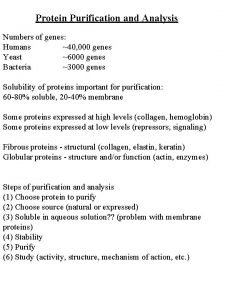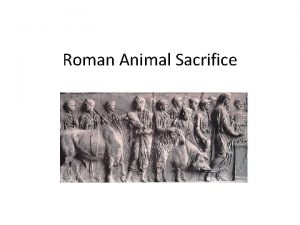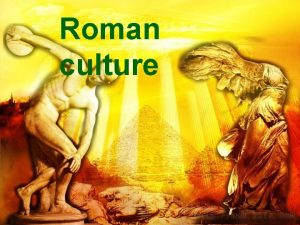Roman Animal Sacrifice Roman Sacrifice 1 Lustration Purification












- Slides: 12

Roman Animal Sacrifice

Roman Sacrifice 1. Lustration (Purification) • Circular procession around the victim, usually three times 2. Procession to the altar 3. Praefatio (Preface) • • Offerings of incense and wine on the altar The opening of ritual space 4. Immolatio • • Pouring of wine over victim’s head Sprinkling back with salted flour Passing sacrificial knife over victim’s spine Prayers transferring the victim from human to divine possession 5. Slaughtering • • Victim is felled and butchered. The corpse is opened up and the vital organs inspected. (If the vital organs look suspicious, the sacrifice needs to begin again with a different victim. ) 6. Banquet • • • Beheading of the victim Vital organs are set aside and prepared as offerings to the gods (either boiled or roasted) Then the meat of the victim was cooked and eaten in a sacrificial meal.

Suovetaurilia The suovetaurilia or suovitaurilia : the sacrifice of a pig (sus), a sheep (ovis) and a bull (taurus) to the deity Mars to bless and purify land (lustratio). http: //en. wikipedia. org/wiki/Suovetaurilia

The ritual is preserved in Cato the Elder's De Agri Cultura, "On Agriculture". The first step was to lead the three animals around the boundaries f the land to be blessed, pronouncing the following words: Cum divis volentibus quodque bene eveniat, mando tibi, Mani, uti illace suovitaurilia fundum agrum terramque meam quota ex parte sive circumagi sive circumferenda censeas, uti cures lustrare. "That with the good help of the gods success may crown our work, I bid thee, Manius, to take care to purify my farm, my land, my ground with this suovetaurilia, in whatever part thou thinkest best for them to be driven or carried around. "

Mars pater, te precor quaesoque uti sies volens propitius mihi domo familiaeque nostrae, quoius re ergo agrum terram fundumque meum suovitaurilia circumagi iussi, uti tu morbos visos invisosque, viduertatem vastitudinemque, calamitates intemperiasque prohibessis defendas averruncesque; utique tu fruges, frumenta, vineta virgultaque grandire beneque evenire siris, pastores pecuaque salva servassis duisque bonam salutem valetudinemque mihi domo familiaeque nostrae; harumce rerum ergo, fundi terrae agrique mei lustrandi lustrique faciendi ergo, sicuti dixi, macte hisce suovitaurilibus lactentibus inmolandis esto; Mars pater, eiusdem rei ergo macte hisce suovitaurilibus lactentibus esto "Father Mars, I pray and beseech thee that thou be gracious and merciful to me, my house, and my household; to which intent I have bidden this suovetaurilia to be led around my land, my ground, my farm; that thou keep away, ward off, and remove sickness, seen and unseen, barrenness and destruction, ruin and unseasonable influence; and that thou permit my harvests, my grain, my vineyards, and my plantations to flourish and to come to good issue, preserve in health my shepherds and my flocks, and give good health and strength to me, my house, and my household. To this intent, to the intent of purifying my farm, my land, my ground, and of making an expiation, as I have said, deign to accept the offering of these suckling victims; Father Mars, to the same intent deign to accept the offering of these suckling offering. "


Sacrifice of a bull. (Temple of Vespasian, Pompeii)

The emperor Marcus Aurelius sacrificing in front of the temple of Jupiter; the flute player stands opposite him. (VRoma: Capitoline Museums, Rome: Susan Bonvallet)

Roman Religious Practice: Animal Sacrifice Denarius issued under Augustus, with a bust of Venus on the obverse, and ritual implements on the reverse: clockwise from top right, the augur's staff (lituus), libation bowl (patera), tripod, and ladle (simpulum)

A denarius minted in Rome by P. Galba (69 BC), shows the secespita (sacrificial knife), simplum (blood-catching vessel) and secures (axe) used in Roman sacrificial ritual.

An Augustan-period altar from Cervetari dedicated to Gaius Manlius shows a male figure with his toga pulled over his head pouring wine onto an altar before which two kneeling victimarii hold the head of a bull while another prepares to swing the sacrificial axe. Behind the bull another victimarius holds the hammer used to stun the bull in his right hand a plate with mola salsa in his left. In front of him stand a flute player and a camillus (boy sacrificial attendant). Vatican Museums, Rome

 What are the objectives of water purification
What are the objectives of water purification Purification and characterization of organic compounds
Purification and characterization of organic compounds Zoogleal layer
Zoogleal layer What are plasmid
What are plasmid Double pot method of water purification
Double pot method of water purification Purification table
Purification table Purification of water on small scale
Purification of water on small scale Gfp purification flow chart
Gfp purification flow chart Ngc protein purification
Ngc protein purification Iises air purification
Iises air purification Edman degradation steps
Edman degradation steps Edman degradation
Edman degradation Benzaldehyde purification
Benzaldehyde purification






















